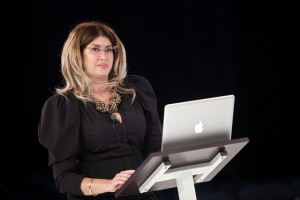ECO Fashion Week Vancouver, September 30th, 2010 // Day three: Summer Rayne Oakes
| Summer Rayne Oakes – Eco-Trends: The Art & Science of Sourcing Sustainably | |
| BIO// Summer Rayne Oakes is a model-activist, author of bestselling style guide Style, Naturally and a young entrepreneur focused on environmental sustainability in business. She has developed more environmentally-preferable collections with a variety of brands, including Payless ShoeSource’s zoe&zac line and Portico Home & Spa. Her unique positioning as both a brand ambassador and environmental strategist keeps her busy on and off camera, advising and consulting on various aspects of design, production and practice. She is now launching a new company called Source4Style, which is an online marketplace that allows designers to purchase more sustainable materials from around the world. Vanity Fair has named Oakes a “Global Citizen,” Outside called her one of the “Top Environmental Activists,” and CNBC called her one of the “Top 10 Green Entrepreneurs of 2010.” Summer Rayne is a graduate of Cornell University with degrees in Environmental Science and Entomology and is a Udall environmental scholar. |
|
| NOTES // | |
| – Background – grew up in NE Pennsylvania country. Brought home insects, etc…. A lot of people in cities never have these experiences!- At University studied sewage sludge; toxic organic contaminants from laundry chemicals, food, body products.
– SRO wanted to reach more people than possible through entomology so headed for fashion. – She headed a beauty shoot with a model and bees in order to highlight the plight of bees – 3 billion dead in the last four years. – Style, naturally – book by SRO. Talking about sustainability good but to get through to fashion, needs a whole infrastructure to support i.e. fabrics available, etc. – Case Study – Payless Shoes – Zoe & Zac $30 and less sustainable shoes. Using water based glues, organic cotton, recycled rubber and cardboard. Recycled packaging, sales of reusable bags with $1 per bag to planting trees in Brazilian forest; $1 per tree – Shipping by rail not air – Portico home – Products get ‘in’ i.e. pillow offers 20% more sleep, plus bonus environmentally friendly. Film campaigns make organic & natural etc. – Source4Style – ‘we source, you design’. Designers spend up to 85% of time sourcing. Market research on annual budget and yards purchased – B2B (business to business). Based online because not all designers make it to tradeshows. Images include close-ups etc. 30 suppliers, 1000+ materials. More coming. – Big brands are signed up ! Adidas, levis, sears, lululemon, MEC, Barneys NY etc – What is sustainable? Organic, recycled, biopolymer, process from farm to factory environmentally friendly, fair trade, fair labor, handmade, traditional,. – Sustainability is a moving target. Continued Improvement is required, full disclosure and transparency required. Ask the right questions to find out what’s really going on with factories etc. – Designers see source4style.com – Suppliers see source4style.com/suppliers – 347.338.110 |
|
| Q&A // | |
– Both. We’ve got the known ones and are open to developing newer ones. Consumer demand dictates this a lot.
– Payless shoes is 50 years old. They have standards. Zoe & Zac has to be tame in terms of design in order to be able to sell and make money and keep design costs down.
– I wanted to work with companies who’re already trying to become environmentally responsible. Big companies who aren’t like that but are at least making an effort are worth helping.
– More brands will be doing this. Eventually brands won’t say ‘green’ or ‘eco’, it’ll just be part of it.
– Once the website is up and running, this will be a good project. My book Style, naturally is used as a teaching aid and several universities have signed up. Students are the future and so this is very important. |
|










